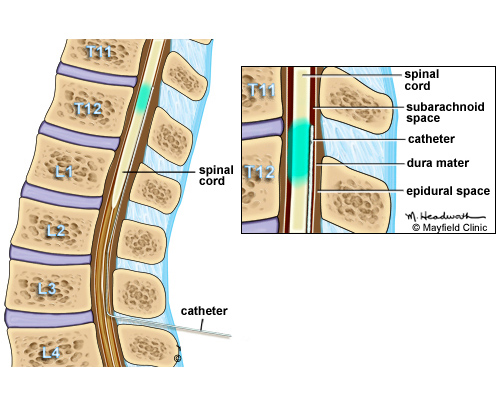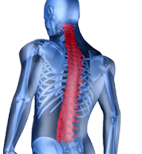Intrathecal (Morphine) Pump Implant

The Intrathecal Pump Implant, also known as the Morphine Spinal Pump, is a treatment option for patients suffering from severe chronic pain who failed other forms of treatment. It is especially beneficial for patients who are unable to tolerate the effects of oral narcotics (pills) and/or no longer receive pain relief from their medication. The intrathecal space is an area in the spine where spinal fluid flows around the spinal cord, the spinal cord being the "power line" that sends pain signals from the body to the brain. When narcotics are introduced into the intrathecal space, the medication goes directly to the site where pain signals travel. The pump, which is about the size of a hockey puck, is surgically implanted into the abdomen. By connecting a catheter from the pump to the precise location in the spine where the pain is, medication (usually morphine) is pumped directly into the spinal fluid.
The medication, which is delivered around the clock, has a much stronger effect than if taken by mouth. Thus, less medication is required and better pain relief is achieved with fewer side effects such as nausea, drowsiness, and constipation. The amount of medication delivered is adjusted in response to changes in level of pain. By placing a radiofrequency transmitter wand over the skin on top of the pump site, the pump is re-programmed to deliver a new dose. Refilling the pump is a simple procedure done in the doctor's office. A small needle attached to a tube is placed into the pump through the skin. The medication is injected through the needle into the pump. Depending on the amount of medication used, the pump is refilled every one to three months.

Procedure Overview:
The intrathecal pump is a two-stage process.
Stage 1 - The first stage or trial is an outpatient procedure. The doctor injects morphine into the intrathecal space to determine how effective the medication is in relieving your pain and how well you tolerate it. After several hours of monitoring you are discharged to home, providing there are no significant side effects. Depending on your condition, the doctor may decide to admit you to the hospital for two to three days to do a more intense trial. A temporary catheter is inserted and a continuous flow of morphine is started and increased until you experience significant pain relief or significant side effects. If either trial is successful in relieving your pain, then a permanent pump is implanted.
Stage 2 – The intrathecal pump implant is performed in the operating room under strict sterile conditions. Depending on circumstances, the doctor may elect to put you to sleep (general anesthesia), or perform under sedation (MAC anesthesia), spinal anesthesia, or just use local anesthesia. You will be adequately sedated and comfortable. Normally, the intrathecal pump implant will take 1-2 hours or longer. When brought to the operating room, you will be connected to monitoring equipment (EKG monitor, blood pressure cuff, and a blood-oxygen monitoring device). The doctor or nurse will start an intravenous line and give some medicine to help you relax. You may also receive an antibiotic. The procedure is performed with you lying on your side. With the assistance of s special X-ray machine called a fluoroscope, the doctor will insert the intrathecal catheter through a small incision in your back. The doctor will then create a pocket under the skin in the right or left abdomen and insert the programmable pump. The catheter is maneuvered from the back, underneath the skin to the abdomen where it is connected to the pump. Both incisions are then closed with sutures. The pump is filled with medication and immediately programmed. You will be monitored in the recovery area for about one hour and then transferred to a room for overnight observation. If there are no signs of problems, you will be discharged the same day or following day.

Before the procedure
Do not eat or drink anything after midnight the day before the procedure. If you are on medications, you may take them with sips of water. If you are a diabetic, discuss your medication with your doctor. You may need to stop taking certain medications several days before the procedure. Please remind the doctor of all prescription and over-the-counter medications you take, including herbal and vitamin supplements. The doctor will tell you if and when you need to discontinue the medications. Tell the doctor if you develop a cold, fever, or flu symptoms before your scheduled appointment.
After the procedure:
You may experience mild soreness in the abdominal wall where the intrathecal pump is placed, and in the back where the catheter is inserted. There may be some bruising which may last up to a week, but will resolve. The sutures are removed in approximately one week, provided the incisions are well healed. Keep the area clean and dry to help prevent skin infection. You may be required to wear a tight binder (girdle type garment) for the next several weeks to aid in the healing process. Depending on the dose of medication delivered, you may experience some numbness and/or weakness and/or sedation. These side effects are normally reversible.
If necessary, your pump can be reprogrammed at any time by the doctor or nurse using an external programmer. You will also be taught how to turn the pump on and off yourself while at home, using a magnet. The pump needs to be re-filled with medication every one to three months. When discharged, please have an adult drive you home or accompany you in a taxi or other public transportation. Depending on how you feel, you may resume normal activities as tolerated in about three or four days. It is important that you always think "safety first" and not engage in any activity that may cause the pump or catheter to dislodge.
Procedure Risks:
The risks are minimal but potentially include: Infection, dislodging of pump or catheter, bleeding, and hardware failure. Please call the doctor right away if you experience any redness or swelling in the area of the sutures, fever, chills, and abnormal sedation.



